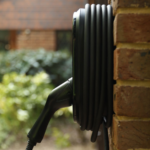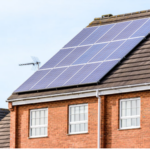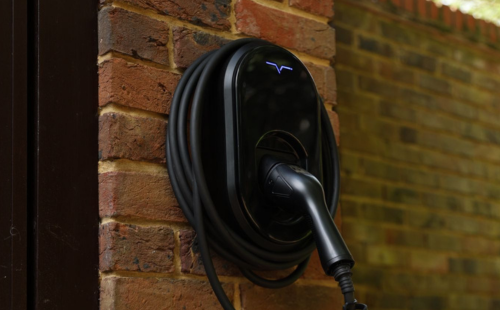
How you’ll benefit from an EV solar-ready charger
20 September 2024
Renewable energy: what’s in it for us?
20 September 2024EV charger connector types: what you need to know
Regardless of whether you’re using your home car charger or a public charge point to fuel your electric vehicle (EV), there is no single EV charging connector that plugs in and powers all cars.
Rather, there are several charger connector types.
These all serve the same purpose, which is to safely and effectively charge and recharge your battery. But it’s essential you know which type to use for your electric car so that, no matter where you are, you’re not faced with any challenges when it comes to topping up your battery.
What exactly is an EV charging connector?
Like your smartphone, all EVs and PHEVs (plug-in hybrid vehicles) have a special socket to plug in a charging cable. This cable connects to a power source that boots up the battery, ensuring your car is ready to rev.
If the charging cable is connected permanently to a charging station it’s known as a tethered EV charger and is generally not longer than 7.5m.
An untethered EV charger necessitates the motorist bringing their own cable when they’re charging outside the home, which can be less convenient.
Conversely, that can also make it more convenient as it allows motorists to connect cables with different connectors, and therefore guarantee they’ll be able to charge whatever EV they’re driving.
Most folk who have untethered EV home chargers do so because these cables are longer. This makes them a handy choice if the home car charger is installed further away than usual from where their EV has to be parked.
The difference between AC and DC charging
Before we dive into the different EV charger connector types, it’s important to know that there are two charging power sources—Alternating Current (AC) and Direct Current (DC). Each charger has different connectors for either of these sources.
AC charging
AC is the primary power source for home chargers and most public charging stations, while DC is used for rapid/ultra-rapid charging.
AC, or an alternating current, is a kind of electric current that can alternate direction (yep, the clue is in the name!) and typically provides power over long distances. This is why the world’s electricity grids use AC power supplies.
In most home EV chargers, AC supports regular charging at speeds of 3.7 kW or 7 kW. In public EV charging stations this generally goes up to 22 kW, which is considered fast charging.
DC charging
However, as the energy stored in batteries is always DC, a converter in your electric car called an “onboard charger” has to transform AC into DC. This is also why fast and ultra-fast EV public chargers using a DC power source are, well, fast—there’s no need for that in-car conversion to happen.
Charging with a direct current supports speeds of 23-100 kW and over. This means your car will be juiced up and ready to rock (hey, we’re talking AC/DC here—we had to make some music references!) much more quickly.
Ultra-rapid public DC chargers, with power levels above 150 kW, are valuable for long-distance travel, allowing EV owners to replenish their batteries quickly during pit stops.
But consistent current charging at high speeds will put your EV on a highway to hell (…OK, we’ll stop now!) The reason is that these kinds of speeds generate excessive heat that degrades your battery much more quickly over time.
In one study on EV battery health, researchers discovered that cars using DC rapid charging at least three times per month, had 10 per cent more battery decline than EVs that never used rapid chargers.
Main EV charger connector types
Now let’s move on to the EV charger connector types themselves.
There are four primary types of charging connectors.
Type 1 and Type 2 EV chargers use an AC power source and allow slow and fast charging.
CHAdeMO and CCS use DC, which allows rapid charging up to 350 kW.
Here’s a breakdown of the characteristics of each one:
Type 1 EV charger connector
- Also referred to as SAE J1772.
- Mostly used in North America and parts of Asia—i.e. Japan.
- Commonly used by Asian EV manufacturers, including Mitsubishi and Nissan.
- Type 1 connectors use Alternating Current (AC).
- They have a flat, rectangular shape.
- They have five pins.
- These plugs are single phase, which means they charge at a maximum of 7kW are used for slow charging.
- While not that common in the UK, some older electric vehicles and charging stations may use Type 1 connectors.
Type 2 EV charger connector
- Also referred to as “Mennekes” after the German company that originally developed them.
- This is the most common connector used for AC charging in the UK and Europe, and they’re the official connector standard for the European Union.
- Commonly used by European EV manufacturers, including Audi, BMW, VW, and Volvo.
- Type 2 connectors use Alternating Current (AC).
- They have a round shape with a seven-pin design and are suitable for both slow and fast charging.
- They are widely used for home charging and public charging stations.
- They can have single phase or 3 phase power so they can charge your EV faster than Type 1 plugs. Many EV home chargers can charge up to 22 kW, while in public charging stations, they can charge up to 43 kW.
CHAdeMO connector
- The name “CHAdeMO” is an abbreviation of “CHArge de Move” or “charge for moving”.
- It was developed in Japan in 2010 as the first fast charger.
- It is still commonly used by Asian EV manufacturers such as Nissan and Mitsubishi.
- CHAdeMO connectors use Direct Current (DC) and charge at a speed of between 50 kW to 100 kW.
- These connectors have a large, round design with eight pins.
- Though Japan continues to develop CHADdeMO capabilities, since 2018, this connector type has started to be phased out in Europe.
Combined Charging System (CCS) connector
- CCS is a universal fast-charging standard that combines AC and DC charging in a single connector.
- It has a two-part design, with a Type 2 connector for AC charging and additional DC pins for fast charging.
- It has different charging speeds that range from 50 kW (most common) up to 150 kW or 350 kW (most rare).
- CCS is becoming increasingly popular in Europe where it is referred to as the CCS2 (in the US it is referred to as CCS1).
- In Europe, it is commonly found in EV cars made by manufacturers such as Audi, BMW, VW and Volvo.
Other charger connector types
Tesla and the NACS
Mention must be given to Tesla, which has been at the forefront of the EV revolution since the early 2000s.
Initially, the company developed its own charging connector that could only be used on its rapid-charging network.
That network grew to become the largest rapid-charging network in the world. But those connectors still posed problems for Tesla drivers who occasionally needed to use non-Tesla charging stations.
Eventually, this forced the company to make several concessions.
For instance, in Europe, it started using CCS2 charger connectors for its electric vehicles. In late 2022, it even shared its EV connector design with other manufacturers and network operators, inviting them to use the design, now known as the North American Charging Standard (NACS), on cars and public charging stations.
Most recently, in another interesting twist, the US government has come out in support of making NACS the standard charging connector in North America. If this happens, it will have to see a phasing out of the CCS2 connector.
However, whatever EV you’re driving, you can always download an app like Zapmap, which allows you to locate thousands of public charging stations with different charging connector types across Britain.
That means you’ll never be without charging options when you’re out and about.
Granny charger
The final charging connector that we want to highlight in this article is the “granny charger”.
This is the portable three-pin plug cable that most EVs come with and which can be used with either Type 1 or Type 2 EV connectors.
While new electric car owners can plug their granny charger into a standard domestic socket to fuel their vehicle, they must be prepared to wait a while before the car’s ready to roll—and by “a while” we mean often as long as a day!
That’s because using granny chargers is the slowest way to power up your car (the clue was actually in the word “granny”, though apologies to all fast-moving grandmums out there!)
These chargers can only charge to a maximum of 2.3kW but are often even slower than that.
In addition, while using a granny charger can offer a short-term solution to keeping your EV fuelled, we recommend not relying on it consistently. It puts a large load on the circuit, particularly if plugged in for a long time, which increases the risk of overheating and electrical blowouts.
If you do need to regularly charge at home, we strongly suggest you install an EV charger at your house or apartment. Powerverse offers a free standard installation when you purchase a state-of-the-art VCHRGD Seven charger. You also receive our data-driven, AI-powered Powerverse app and customer support both pre- and post-installation.
The VCHRGD Seven charger has been rigorously tested by Powerverse and is approved by the Office for Zero Emission Vehicles. It comes with a three-year warranty and a 14-day cancellation policy. You can find out more about our offer here.
About Powerverse
We’re industry experts in home energy management. Our easy-to-use app is built for your future electric home. It will effortlessly sync your solar, battery, heat pump, EV charger and more, helping you cut costs and your carbon footprint on your way to becoming energy-independent. Curious to know more? Talk to one of our experts.

